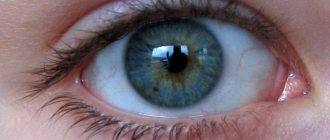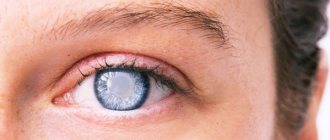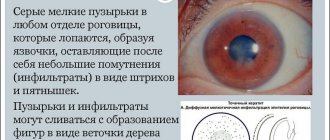How twilight vision works
The human eye is very sensitive to external changes. Visual receptors detect light through the retina. This organ consists of rods and cones, which are responsible for the perception of color and light intensity. Night blindness occurs when the receptors have difficulty distinguishing surrounding objects at night or in the twilight. The work of rods and cones depends on the quality of lighting in the surrounding space. Therefore, there is a difference between day and night vision. All receptors are activated for better perception at dusk; light rays are caught faster in the dark.
Rhodopsin, located in rods, affects the functioning of the optic nerve. This enzyme breaks down in the light and is restored in the dark, so it takes a long time for a person to adapt to the dark. Vitamin A affects the quality of twilight vision because it is part of rhodopsin.
Problems with twilight vision occur when there is a lack of vitamin A. Dark adaptation occurs when the visual system operates at night or in twilight. The eyes operate in a black-and-white spectrum, so all visible objects appear gray.
About the reasons for the deterioration
There are several reasons, but almost all of them are associated with a change in the ratio of cone and rod cells or with insufficient production of rhodopsin. This problem has a medical name - hemeralopia, people called it funnier - night blindness. Chickens also see well during the day, but practically go blind in the evening.
If the pathology is transmitted genetically, then it is congenital and cannot be treated. Another reason is retinitis pigmentosa, the so-called degenerative processes in the retina when sensitive cells die. The first to suffer are the sticks that are located at the edges, then the person ceases to see clearly in the twilight.
If this condition is triggered, vision can become tunnel vision, when its boundaries become very narrow and peripheral vision disappears.
Hemeralopia can develop against the background of other visual pathologies, for example, severe myopia, glaucoma, retinopathy, cataracts, retinal detachment, and death of the optic nerve. Night vision can become worse with a deficiency of vitamins such as A, B2, PP. This happens with diabetes, following strict diets, diseases of the stomach and intestines, in which the absorption of nutrients and food is impaired. An important point: many years can pass from the moment a deficiency is created to the manifestations of hemeralopia, since the body stores vitamin A for future use.
The provoking factor may be a previous infectious disease, for example, measles, herpes, rubella or chickenpox. Often, night vision decreases in vegetarians and women with the onset of menopause.
Classification
Night blindness is divided into several types depending on the cause of its occurrence:
- congenital;
- essential;
- symptomatic.
Congenital is inherited from parents and manifests itself in childhood and adolescence. Genetic disorders often cause vision problems.
These include:
- Usher syndrome;
- retinitis pigmentosa, inherited.
The essential form is a functional disorder of the retina caused by a lack of beneficial microelements. Metabolism is often difficult due to various diseases.
Examples:
- liver diseases;
- unbalanced diet;
- alcohol abuse;
- rubella;
- damage by toxins;
- long exposure to bright lighting.
Symptomatic night blindness occurs with various eye diseases, disorders of the retina or nerve tissue.
Examples of diseases:
- high myopia;
- glaucoma;
- retinal dystrophy;
- atrophy of nerve tissue;
- chorioretinitis.
Ophthalmologists detect false night blindness when vision is impaired in the dark or in dim lighting due to fatigue. Working long hours at the monitor or relaxing in front of the TV have a bad effect on the condition of the receptors. The quality of vision improves after rest; severe eye strain causes serious illness.
How to improve twilight vision
An ophthalmologist will tell you how to improve such vision. The main method is to enrich the body with vitamin A. For this purpose, the following products should be included in the diet:
- berries (black currants, blueberries);
- milk and milk-containing foods (sour cream, kefir, cheese, cottage cheese);
- greenery;
- eggs;
- fish dishes, cod liver;
- vegetables (corn, green peas, carrots);
- fruits (oranges, apricots, persimmons, peaches).
Alternative medicine will help you cope with night blindness:
- Dried blueberries are brewed with boiling water, left for 4 hours, strained and consumed 100 g of infusion three times a day.
- Nettle is crushed, poured with hot water, kept for an hour and consumed on an empty stomach 3 times a day, two tablespoons.
- Fresh sea buckthorn berries are brewed with boiling water, left for 30 minutes, filtered and taken 2 times a day after meals, adding a little sugar or honey to the drink.
- Grape and carrot juice and fish oil have a positive effect on the functioning of the visual apparatus.
Traditional methods should be used on the recommendation of an ophthalmologist.
No medications can help with congenital hemeralopia. The acquired disease is treated depending on the causes of its occurrence.
Diagnostics
Diagnostic methods:
- visual acuity in dim lighting is determined;
- the size of the visual field is measured separately on each eye, the area that the fixed organ is capable of covering is determined;
- color perception analysis is carried out;
- ophthalmological examination of the fundus;
- electroretinographic analysis reveals nerve impulses in the retinal area;
- adaptometry is a technique that reveals dark adaptation;
- tonometry is performed to measure intraocular pressure;
- vision adaptation is determined in low light, the time during which the eye gets used to the dark is set;
- The general condition and quality of the retina is studied.
Additional examination by a gastroenterologist reveals vitamin A deficiency.
Twilight vision and driving
Decreased twilight vision can significantly impair a person's quality of life and have unpleasant consequences. This violation poses a great danger to drivers working in the evening.
People driving a car are recommended to use polarized visors, as well as special glasses to prevent the headlights of oncoming traffic from blinding them.
These glasses with orange and yellow lenses (anti-headlights) must be worn in the evening and at night: they eliminate glare, reduce the glare of light, and also improve color perception.
It is believed that rods are not sensitive to red light. Therefore, drivers can also put on glasses with red lenses half an hour before driving at dusk.
In order not to worsen twilight vision, you should not look at the light source in the evening or at night: your eyes will need a long time to adapt to twilight. If this is not possible, you should look at the light with one eye and cover the other.
A simple method will help to slightly improve twilight vision. While in the dark, you need to massage your eyeballs for a few seconds by pressing on the eyelids with your fingers. After a short time, the field of view begins to brighten. After waiting for the black color to appear, you should open your eyes. Thus, the visual system will quickly adapt to twilight.
Treatment
Therapy is possible only in a situation where night blindness is acquired. Congenital pathology cannot be treated. Therefore, first the ophthalmologist determines the cause of the disease. The doctor gives advice on changing your diet to get more vitamin A and other microelements necessary for the normal functioning of visual receptors.
Recommended Products:
- Cod liver;
- dairy products;
- egg yolks;
- corn kernels;
- legumes;
- orange fruits and vegetables.
The diet is prescribed individually to each patient; compliance with specialist recommendations affects the speed of recovery. Traditional medicine helps improve metabolism. Before using them, it is necessary to conduct an examination and identify contraindications. Since vitamin A is a fat-soluble substance, it is necessary to supplement the diet with foods containing vitamin B2.
Treatment options
Important! If the disease is caused by glaucoma, cataracts or other problems with the retina, then visual impairment can be dealt with by eliminating the underlying disease.
Sometimes the patient may require surgery. Most often, this problem occurs in old age.
If the disorder is caused by a lack of vitamin A, the patient requires a special diet .
The patient's diet must include the following foods:
- carrot;
- eggs;
- tomatoes;
- cheese;
- millet;
- vegetables and fruits;
- berries;
- Cod liver;
- spinach;
- nuts;
- seeds.
In addition, it is important to normalize your daily routine . It is necessary to give the body time to fully recover.
Another useful addition is eye exercises.
You can perform it at any time of the day, for example, while watching a movie or reading a book.
Sometimes specialists prescribe vitamin preparations for patients to instill into the eyes .
The task of such funds is to normalize oxygen supply to tissues and restore impaired blood circulation. One such drug is Riboflavin.
Prevention
Adviсe:
- reduce the time spent working at the monitor and watching TV;
- additional lighting sources are installed;
- eyes rest every 40 minutes when working with documents or small objects;
- reading in the dark from electronic devices is prohibited;
- the light will be distributed evenly so that the receptors are not overloaded;
- glasses with an ultraviolet filter are used when hiking in the mountains to prevent reflected rays from blinding a person.
Definition of twilight vision
Hemeralopia is a disorder of the visual system that occurs as a result of pathological phenomena in the retina and is accompanied by decreased vision and poor adaptation in space in dim conditions.
The retina of the eye contains photoreceptors - cones and rods. Cones allow people to see colors and details in daylight. The rods contain visual purple (rhodopsin), which is sensitive to light and is activated in the dark, allowing the eyes to adapt to dim light. It is the rods that are responsible for visual ability in the dark. However, for good visibility in the dark, the ratio of both types of photoreceptors is important.
In poor lighting, people do not see as clearly as some animals and do not distinguish between color shades, but in the absence of light they are quite capable of orienting themselves in space.
When lighting changes, the eye begins to adapt to new conditions. People with twilight vision disorder are able to see clearly in daylight, but when evening comes, their eyes seem to become foggy.
Hemeralopia is a dangerous phenomenon. Narrowing of the boundaries of visual fields, insufficient orientation in the dark, as well as loss of the ability to distinguish between yellow and blue shades often lead to maladaptation and even loss of motor coordination.
Causes of twilight vision disorders
Numerous studies prove that hypovitaminosis plays an important role in the development of hemeralopia. Pathology occurs due to an acute lack of vitamins A, B2 and PP.
A lack of vitamin A causes drying, thickening and redness of the conjunctiva, reduces the secretion of glands, provokes various disorders of the sensitivity of the cornea and its clouding.
It is also noteworthy that vitamin A is involved in the process of photoreception (light absorption by photoreceptors). A lack of vitamin A causes massive destruction of rods in the retina, which becomes the first sign of impaired twilight vision.
Diagnosis and treatment of hemeralopia
Medicine distinguishes between congenital and acquired hemeralopia. Even modern treatment methods cannot cure the congenital form.
Methods for diagnosing hemeralopia:
- ophthalmoscopy (examination of the fundus, examination of the retina, optic nerve, blood vessels);
- biomicroscopy (examination of the eye using a slit lamp);
- tonometry (measurement of intraocular pressure);
- visometry (determining visual acuity using a table);
- color vision research (the study of color perception based on color schemes).
It must be remembered that the treatment of hemeralopia is determined differently in each case, so you should not take any drugs uncontrollably. First, you need to find the cause of the disease, and the results of the examination will show what the body really lacks. Consultations from other specialists will not be superfluous.
If there is a cause for the defect, appropriate therapy is prescribed. Often these are vitamin complexes and treatment of pathologies of the visual system that provoke twilight vision disorders.
Pathologies of the visual system
When the cause of hemeralopia is myopia, therapy will consist of laser vision correction. Refractive surgeries (scleroplasty, lens replacement, etc.) can also be used.
In case of retinal detachment, urgent laser coagulation is necessary. Glaucoma requires antiglaucomatous surgery, and cataracts require extraction or phacoemulsification.
Hypovitaminosis
To determine the concentration of retinol, carotene and vitamin A in the blood, an appropriate test is prescribed. When the levels of these components decrease, corrective therapy is required.
If the cause of hemeralopia is a vitamin deficiency, therapy will include the following measures:
- normalization of diet;
- balancing the diet;
- taking vitamins and nutritional supplements.
Often, for essential hemeralopia, medications with beta-carotene are prescribed. This is provitamin A, but it does not cause side hypervitaminosis. The course of treatment also includes vitamins A, C, E, lutein and trace elements (zinc, selenium, copper). These components are the basis of therapy for twilight vision disorders caused by a lack of vitamins.
What is hemeralopia
Visual impairment in twilight conditions is known to medicine as hemeralopia. It is noteworthy that this disease has no degrees: either there is a deviation or there is not. Despite this, impaired vision at dusk greatly interferes with a person’s life, leading to dangerous consequences.
Hemeralopia is popularly called night blindness. This is a visual disorder that is caused by pathology of the retina and optic nerve. Violations lead to a significant decrease in visual acuity in twilight and dark conditions.
Symptoms of hemeralopia:
- weakening of visual function;
- disturbance of spatial orientation in the dark;
- defect of light adaptation;
- narrowing of visual fields.
Sometimes the symptoms of night blindness are complemented by an incorrect perception of shades of yellow and blue. Medicine knows the so-called false hemeralopia, when visual acuity at dusk decreases temporarily. This occurs due to eye strain when working at a computer or with small print. However, not all doctors agree with this definition of the condition, because hemeralopia cannot be relative.
Representatives of both sexes suffer equally from hemeralopia, but it has been observed that during menopause women are more likely to have problems with twilight vision. This is due to various endocrine changes that occur with age in the body of women.
How to keep your eyes healthy while driving
To reduce the impact of negative factors on eye health, drivers should choose the right glasses for driving in different conditions.
On a bright sunny day, you need sunglasses with soft brown lenses with a polarized coating; such glasses will protect your eyes from bright sunlight and at the same time from the glare of the sun reflected from snow and ice, wet road surfaces, and car glass. In the dark and in conditions of poor visibility, for example, in fog or rain, you should use glasses with an anti-reflective coating, thanks to this more light enters the eyes and improves visibility. Also, driver's glasses for the dark can have a yellow tint, which eliminates the influence of the blue component of light, has a relaxing effect for the eyes and improves image contrast. Pay special attention to the frame: the glasses should not press anywhere and should not slide down to the nose so as not to distract from driving. The frame of the glasses should provide maximum visibility.
To make it easier on your eyes when driving, remove any objects from your field of vision, such as small items and decorations on the rearview mirror and windshield. It is better not to tint your car windows so as not to reduce visibility. Try to ensure maximum comfort in your driver's seat, since driving causes disruption of the blood supply to the muscles of the collar area, which also has a bad effect on vision. Do not drive for more than 2 hours in a row, stop and do a warm-up, and give your eyes a rest. Close your eyes, move your eyeballs sideways and up and down to relax the muscles, massage the bridge of your nose.
Remember to regularly visit your ophthalmologist at least once a year, especially if your visual acuity is reduced. After all, clear vision and correctly selected correction are the key to safety on the road and the health of your eyes.











